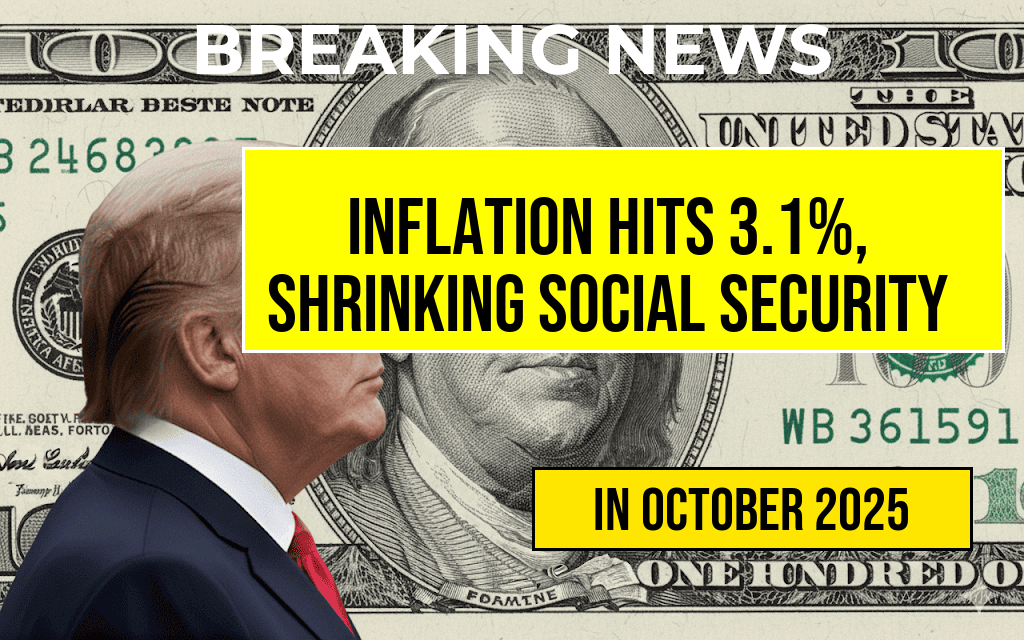Inflation has surged to a significant 3.1% in the latest Core Consumer Price Index (CPI) report, a development that is raising concerns for millions of Americans, particularly retirees relying on Social Security benefits. The increase in inflation is outpacing the recent $49 adjustment in Social Security payments, effectively eroding the additional financial support intended to help retirees cope with rising living costs. As the cost of essentials such as food, housing, and healthcare continues to climb, the implications for seniors and low-income households could be severe, prompting calls for policy reviews and potential adjustments in future benefit increases.
Understanding the Core CPI Increase
The Core Consumer Price Index, which excludes volatile items like food and energy, is a critical measure used by the Federal Reserve to gauge inflation trends. The latest report indicates that the core inflation rate has increased from 2.7% to 3.1%, reflecting ongoing pressures in the economy. Rising prices in sectors such as shelter, healthcare, and transportation have contributed significantly to this increase, highlighting persistent inflationary trends that are not likely to subside in the near term.
Impact on Social Security Benefits
This year, Social Security beneficiaries received a $49 increase in their monthly payments, a result of the annual Cost-of-Living Adjustment (COLA). While this increase was intended to provide some relief, the recent inflation surge means that the purchasing power of that additional money has been significantly undermined. For many seniors, this adjustment is not sufficient to cover the higher prices they face daily.
- Housing Costs: With rental prices steadily rising, many retirees are finding their housing expenses consuming a larger portion of their income.
- Healthcare Expenses: Medicare premiums have also seen an uptick, adding financial strain on those who rely on these services.
- Food Prices: Grocery bills have escalated, forcing many to adjust their budgets significantly.
Policy Responses and Future Adjustments
The ongoing inflation crisis has prompted discussions among policymakers about the adequacy of the current Social Security adjustment mechanisms. Experts argue that the formula used to calculate COLA may need reevaluation to better reflect the actual expenses faced by retirees. Many advocate for a more responsive measure that considers the specific inflation experiences of older adults, particularly in areas like healthcare and housing.
Public Sentiment and Economic Outlook
Public sentiment is increasingly critical of how inflation impacts fixed-income individuals. Many retirees express frustration over the perceived inadequacy of the current adjustments, which seem disconnected from their real-life financial challenges. This frustration is echoed by advocacy groups that emphasize the need for immediate action to address these disparities.
| Year | Social Security Increase | Core CPI Increase |
|---|---|---|
| 2022 | $92 | 6.2% |
| 2023 | $49 | 3.1% |
Looking Ahead
As inflation continues to pose challenges across the nation, particularly for vulnerable populations, the need for robust policy solutions has never been more pressing. Adjustments to Social Security benefits, along with broader economic strategies to manage inflation, will be crucial in supporting millions of Americans. Stakeholders, from policymakers to advocacy groups, must work collaboratively to ensure that the financial stability of retirees is prioritized in future economic planning.
For further insights on inflation and its effects, you can visit Forbes and Wikipedia.
Frequently Asked Questions
What is the current rate of inflation as reported in the article?
The current rate of inflation is reported at 3.1% for the Core CPI.
How does the 3.1% inflation rate affect Social Security increases?
The 3.1% inflation rate erodes the value of the recent $49 Social Security increase, diminishing its purchasing power.
What is Core CPI and why is it significant?
Core CPI measures the change in prices of goods and services without the volatility of food and energy prices, making it a key indicator of long-term inflation trends.
How often do Social Security benefits get adjusted for inflation?
Social Security benefits are typically adjusted annually based on the changes in the Consumer Price Index, including the Core CPI.
What can individuals do to mitigate the impact of inflation on their finances?
Individuals can consider diversifying their investments, seeking higher interest savings accounts, and budgeting more effectively to mitigate the impact of inflation on their finances.











